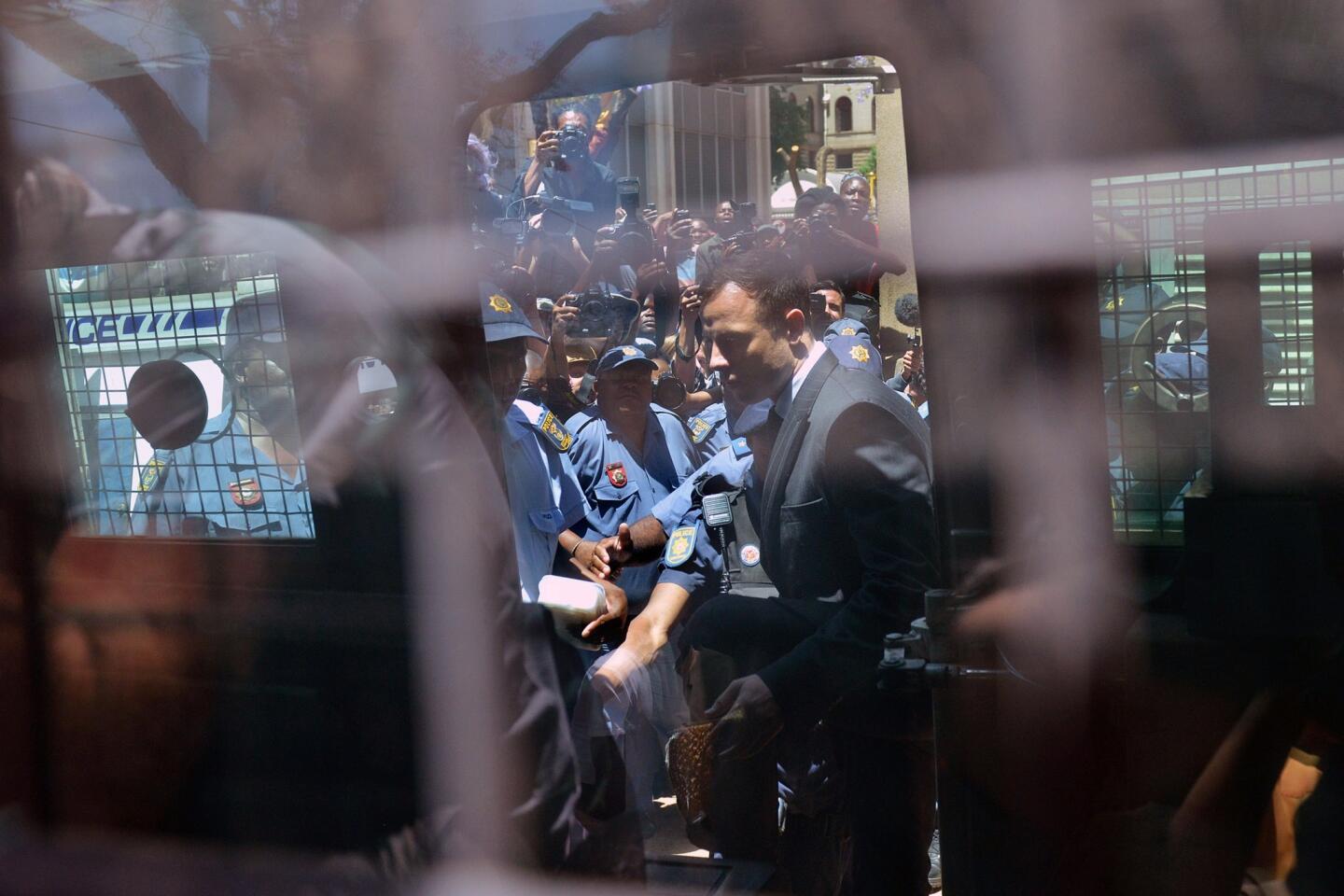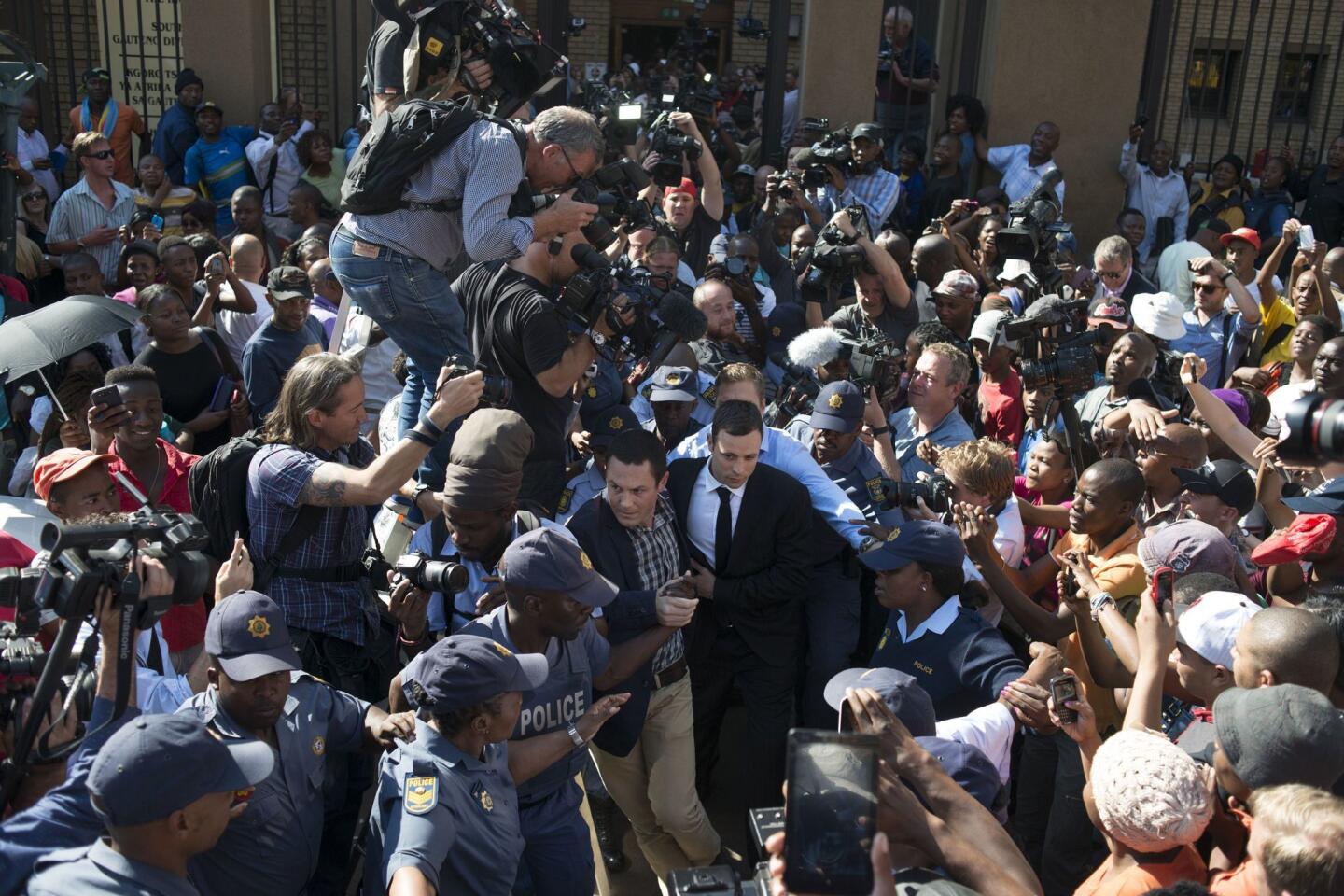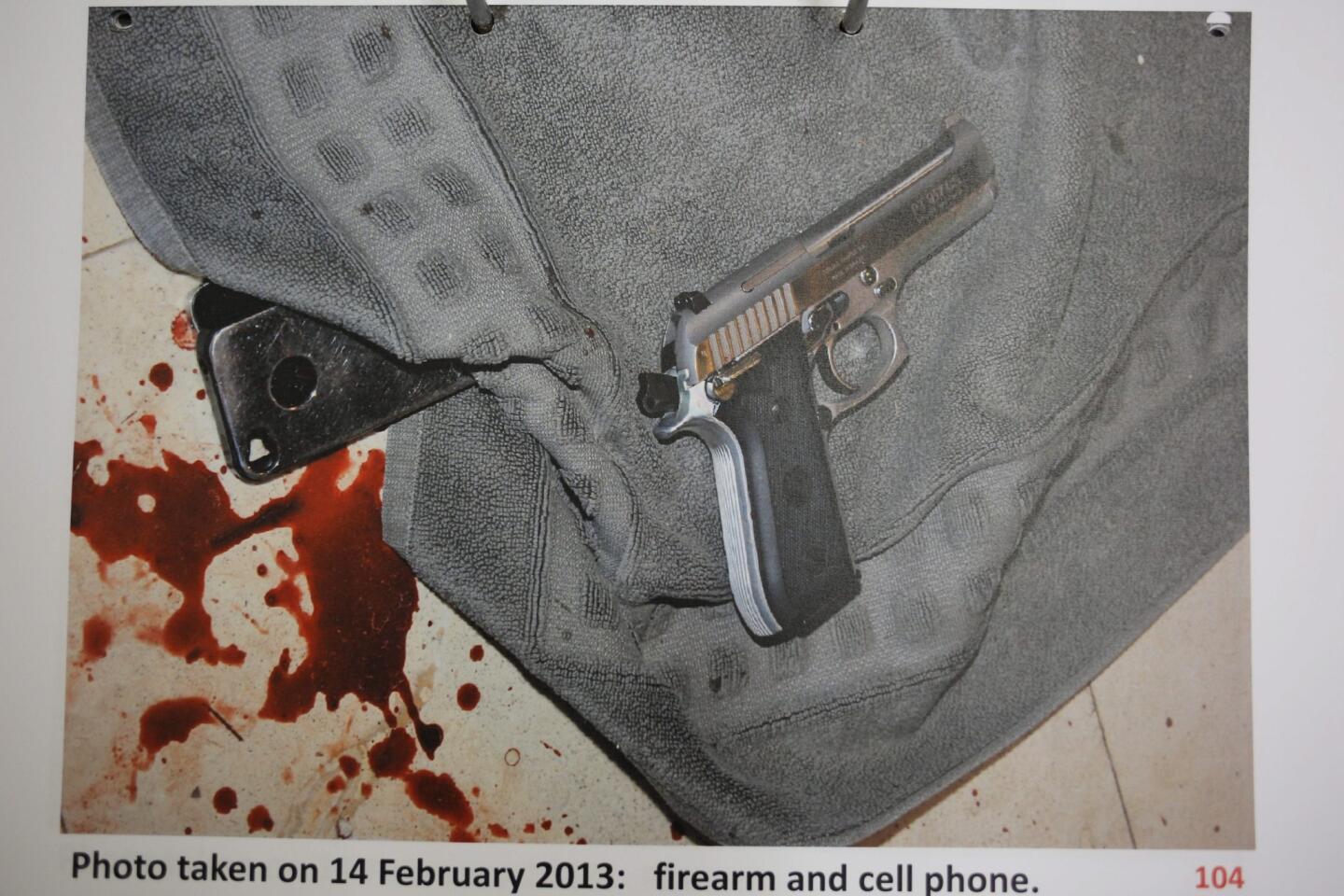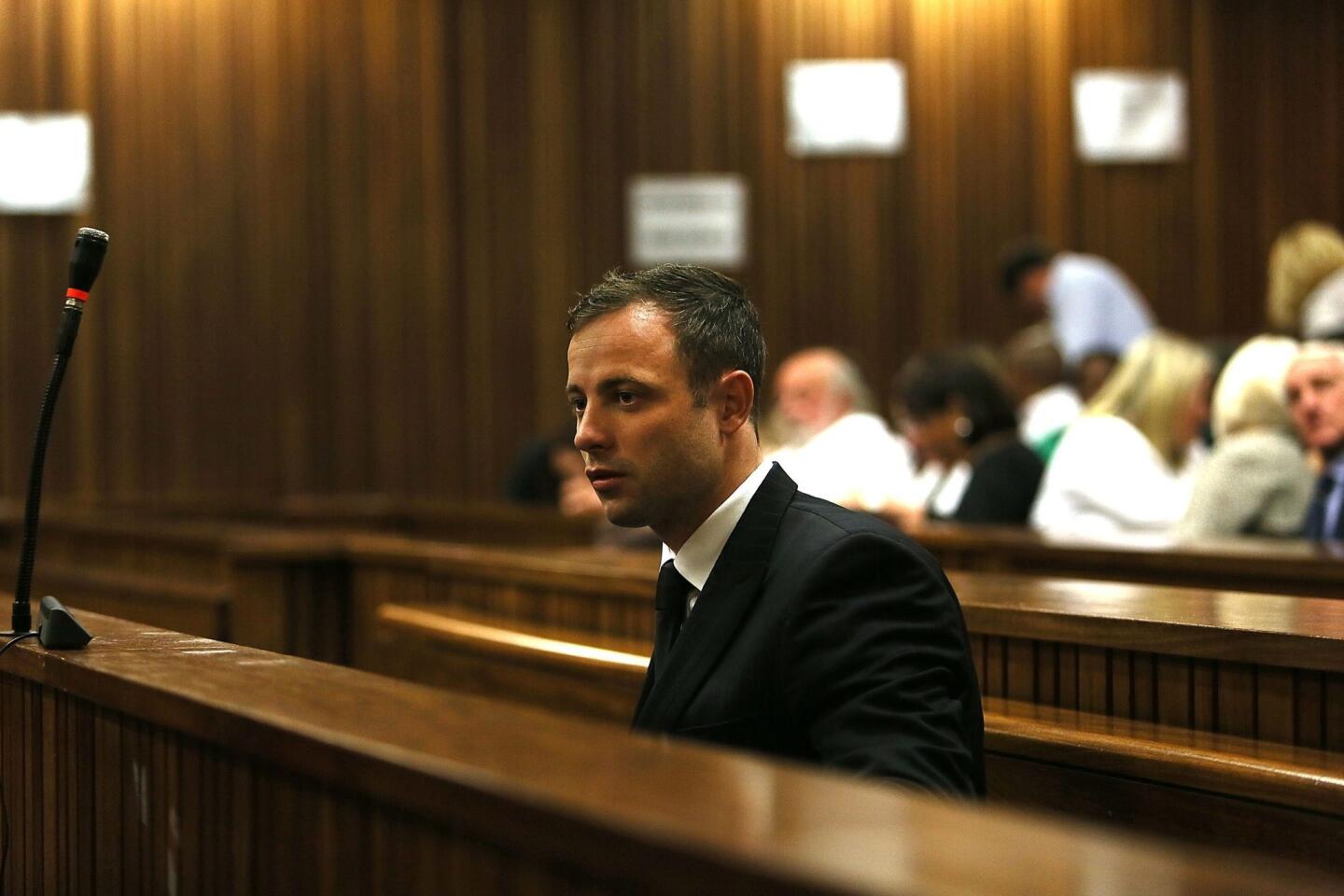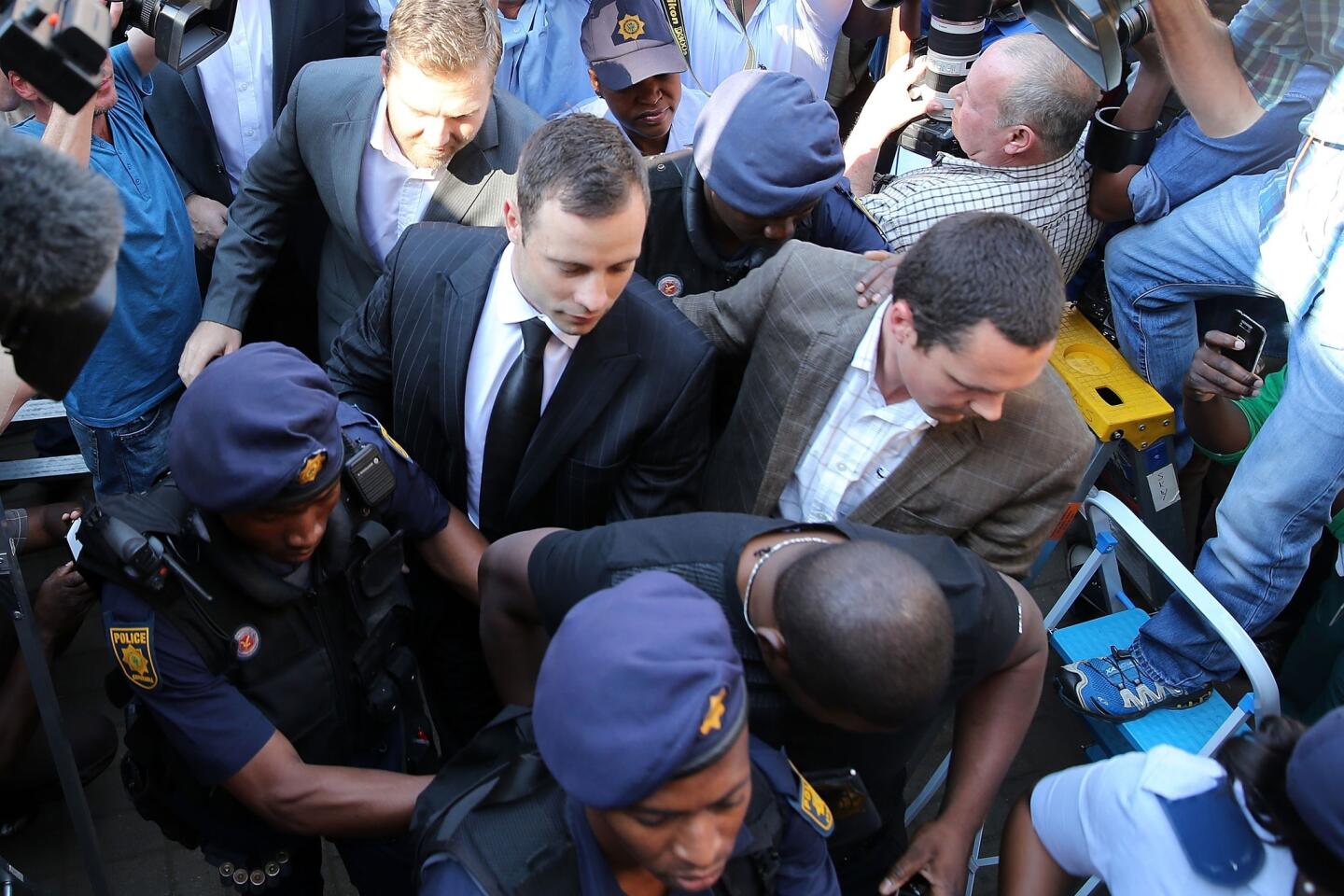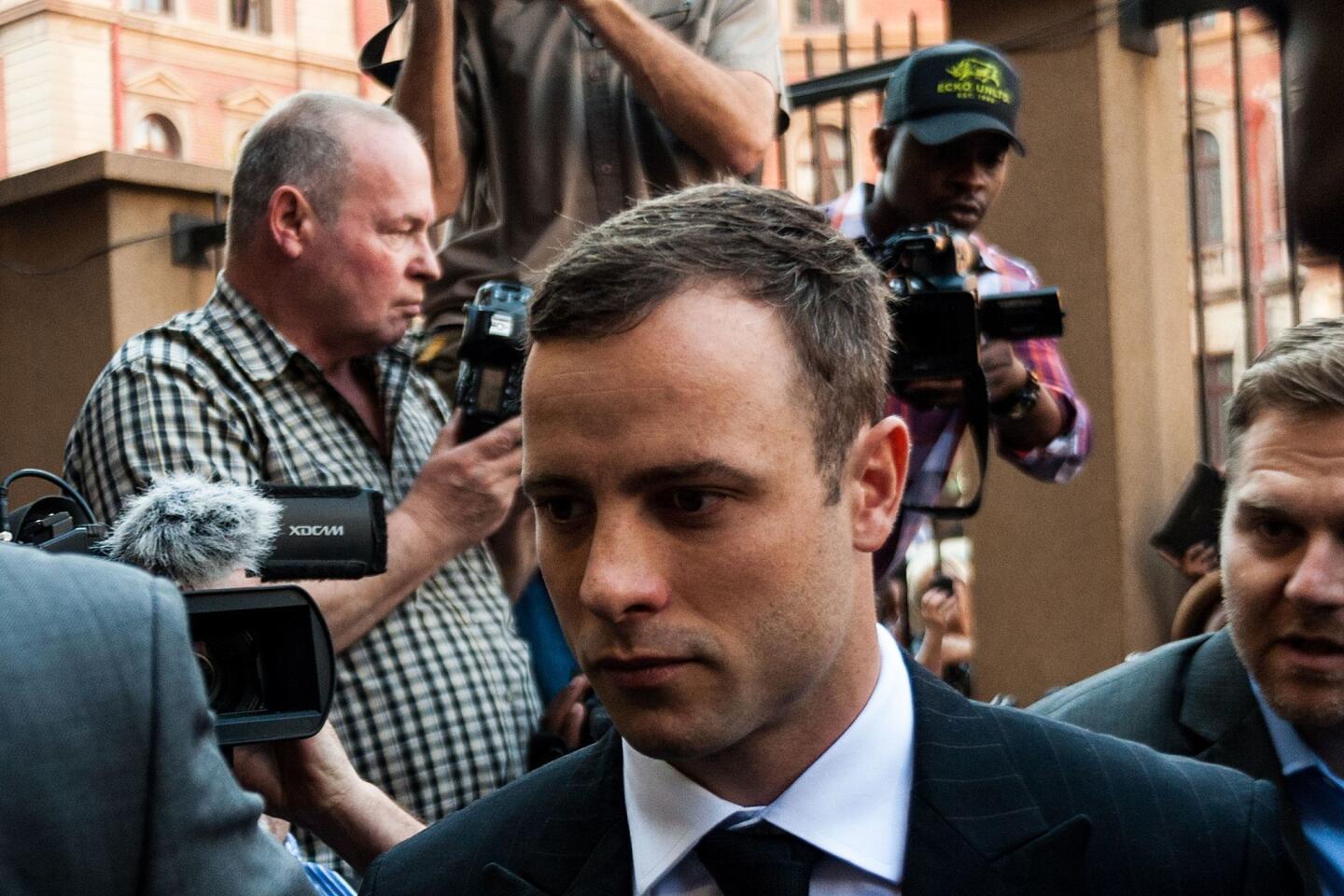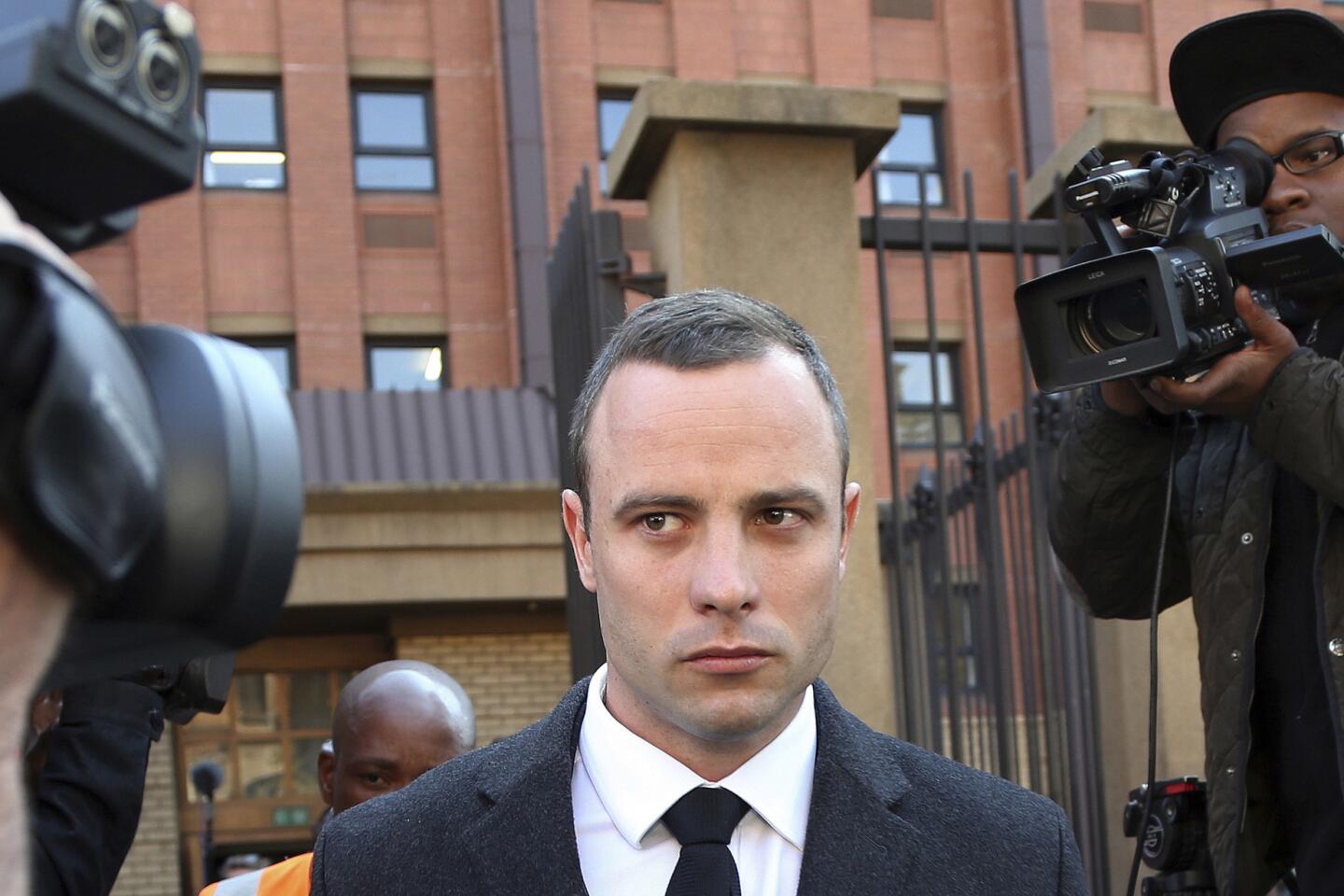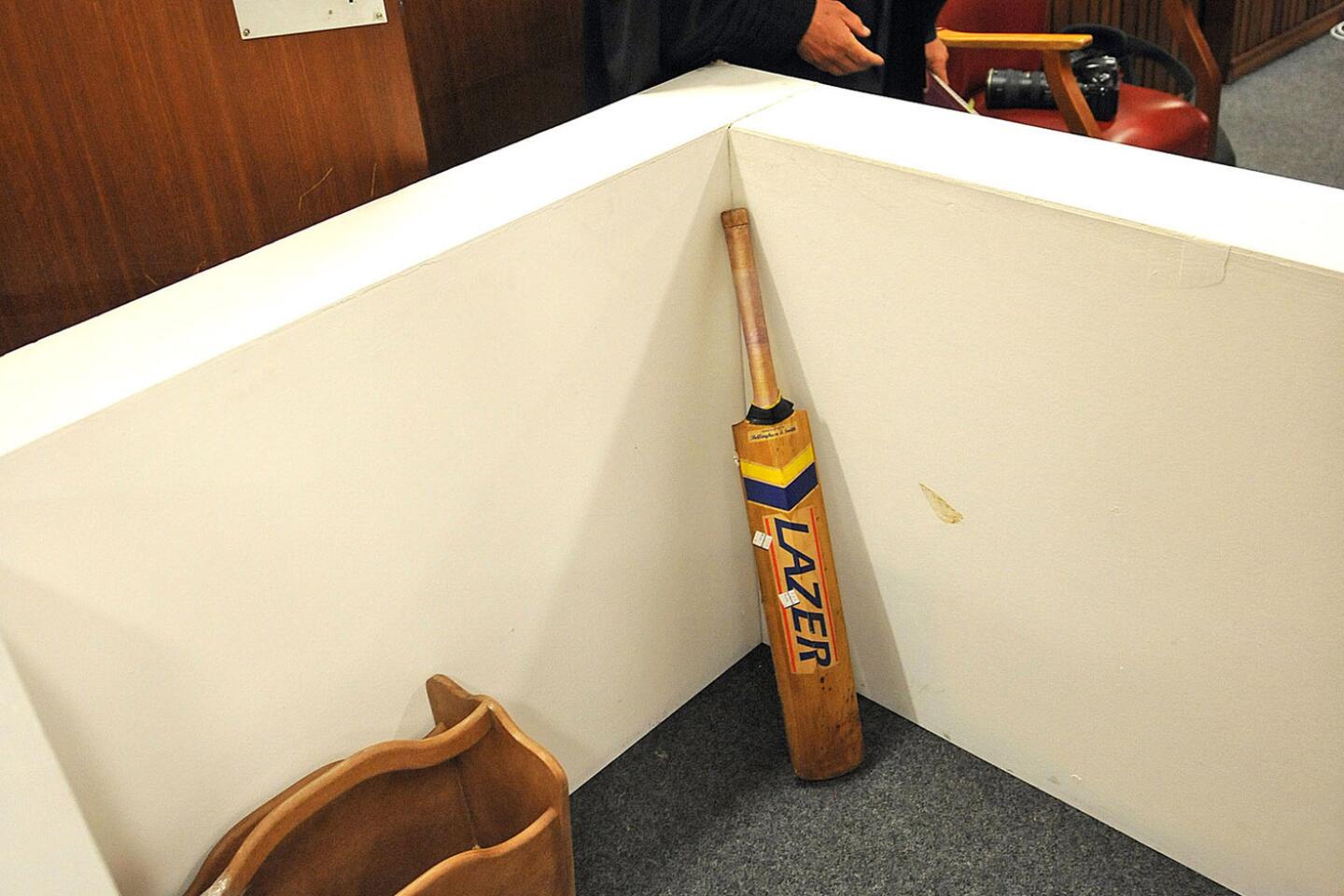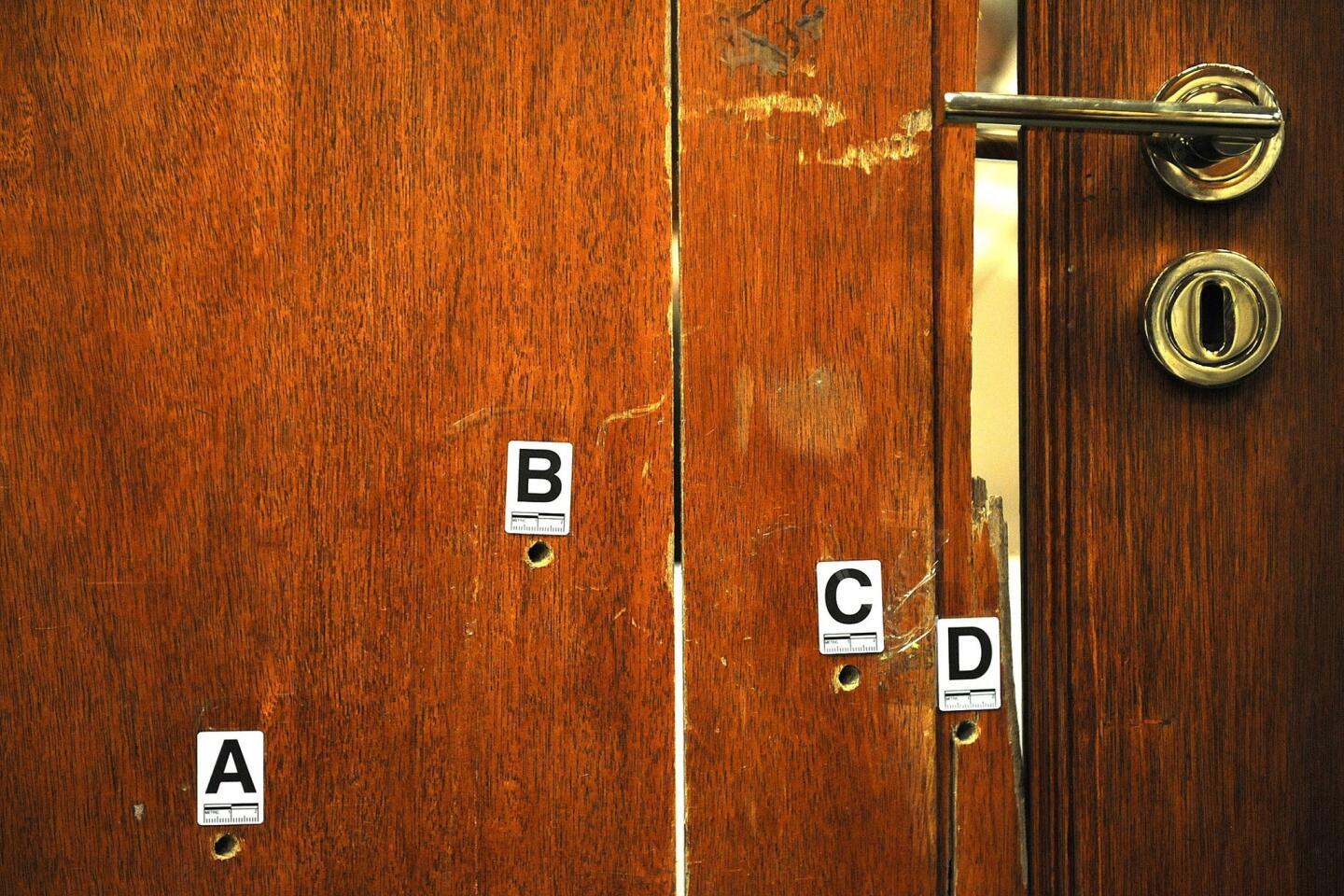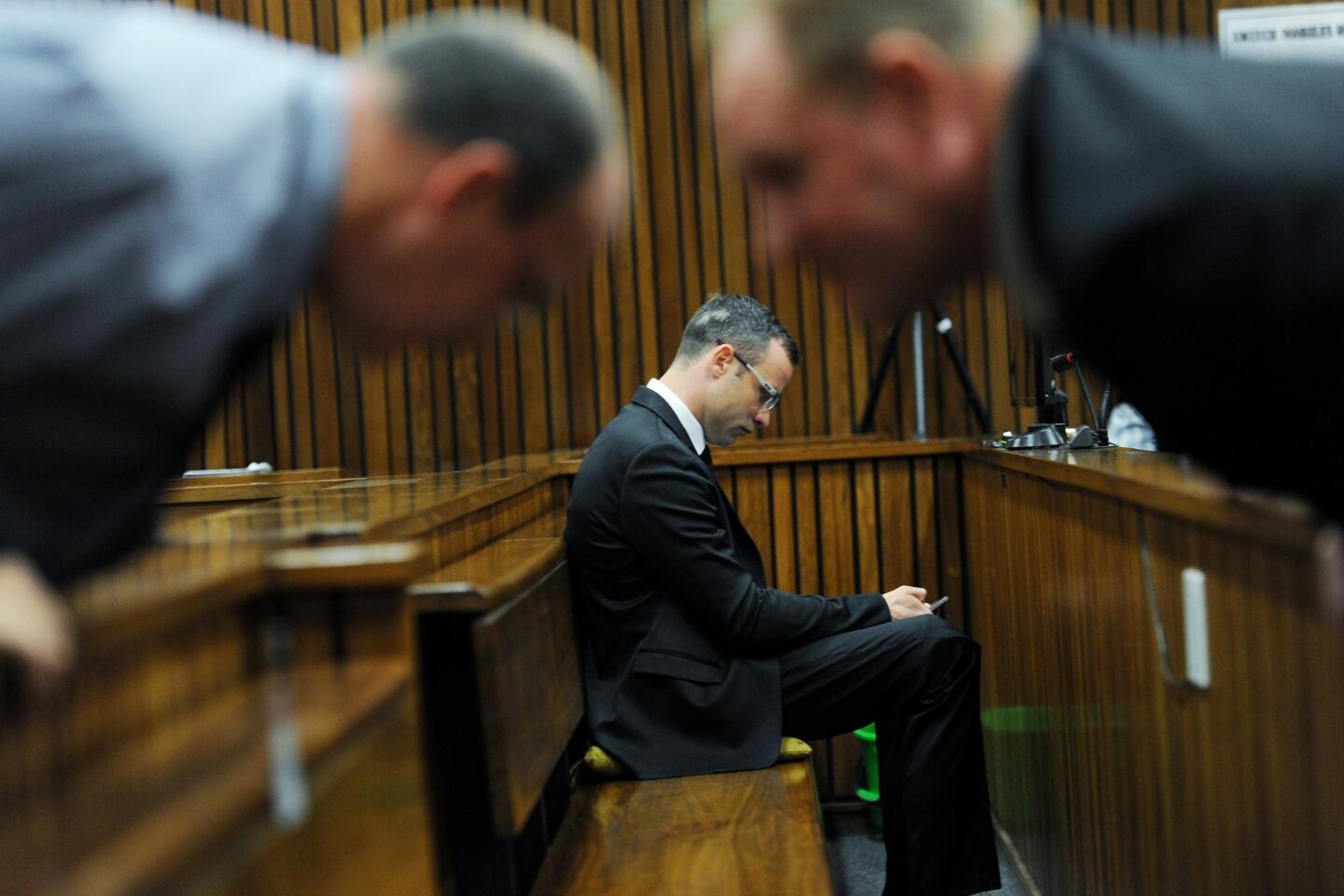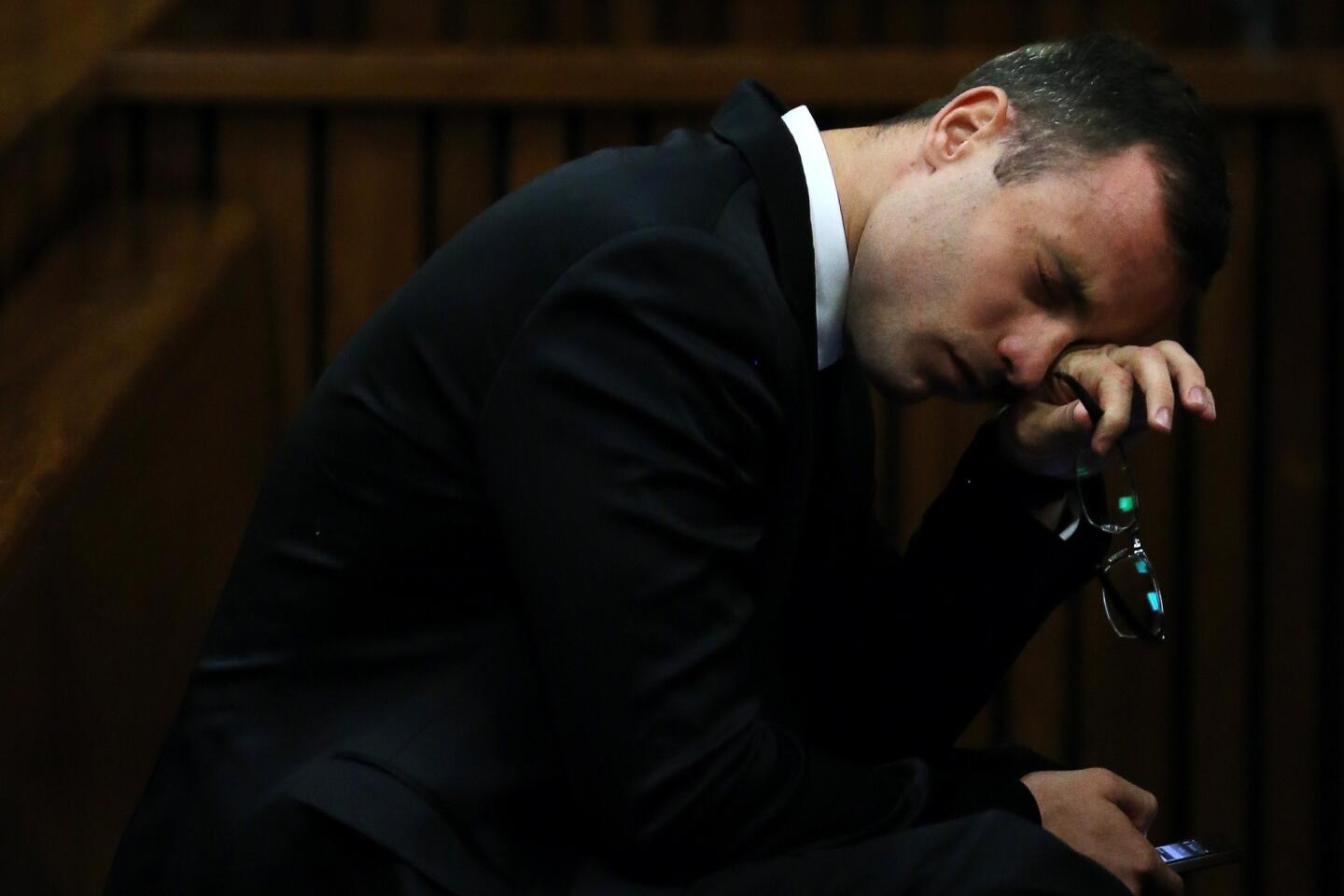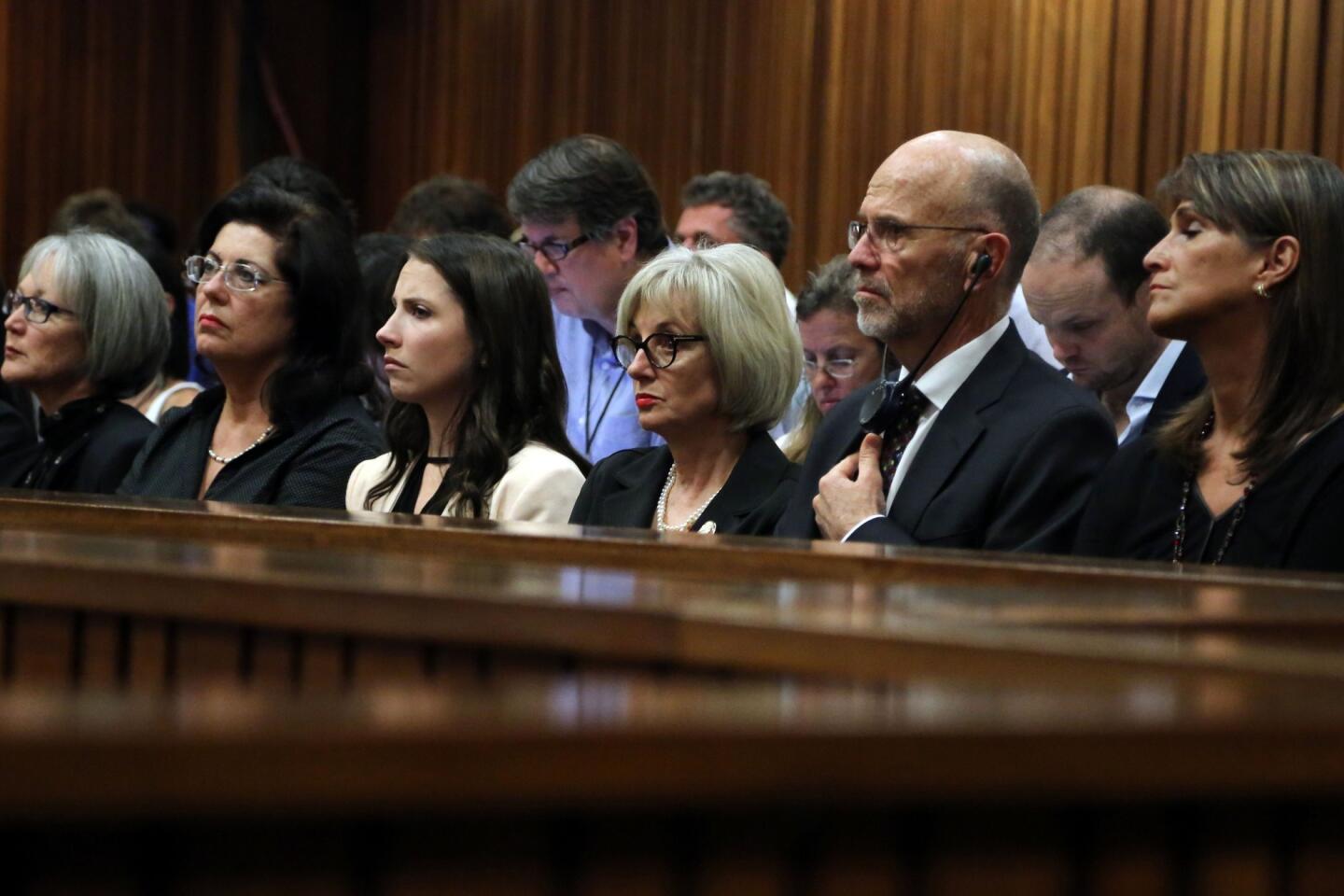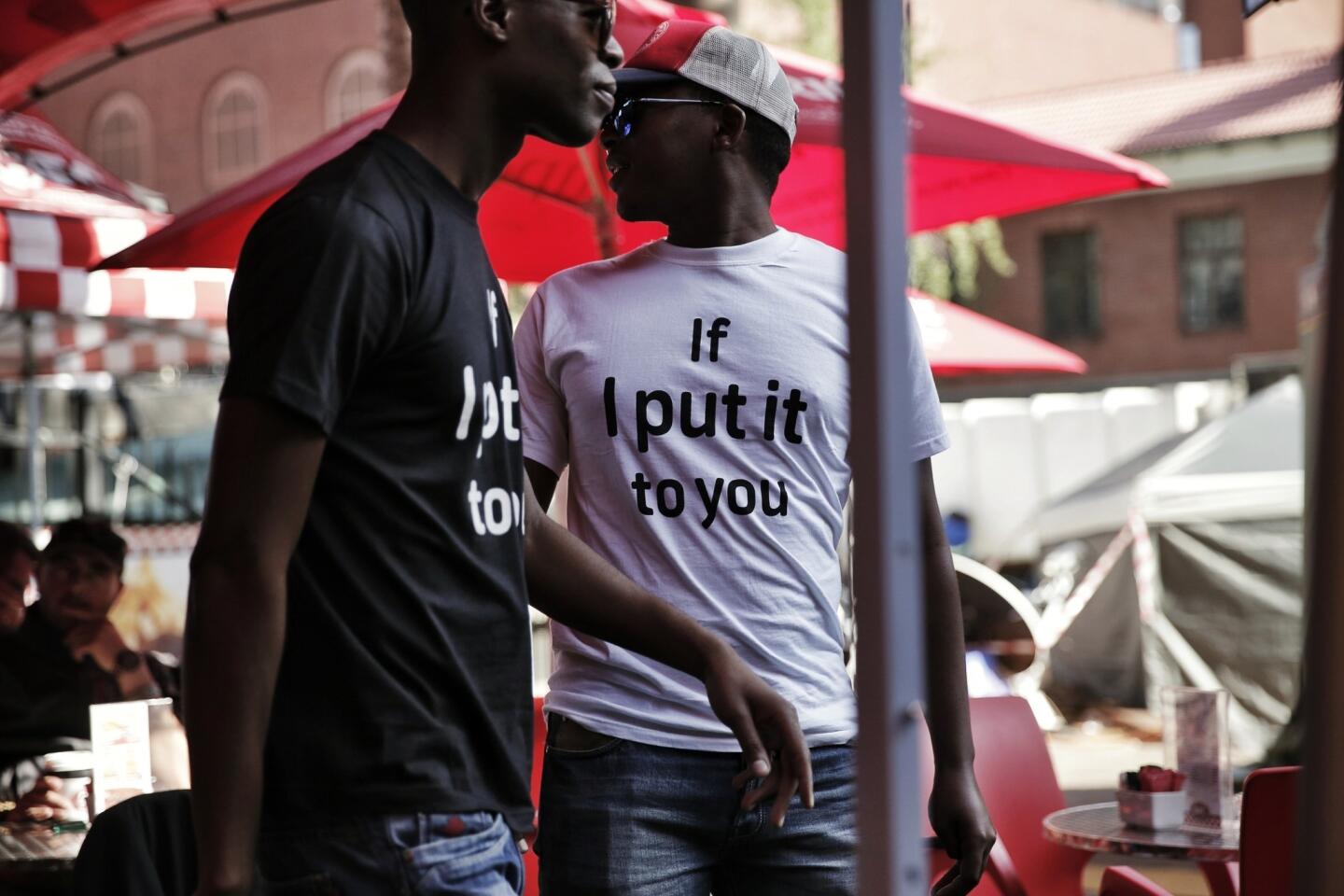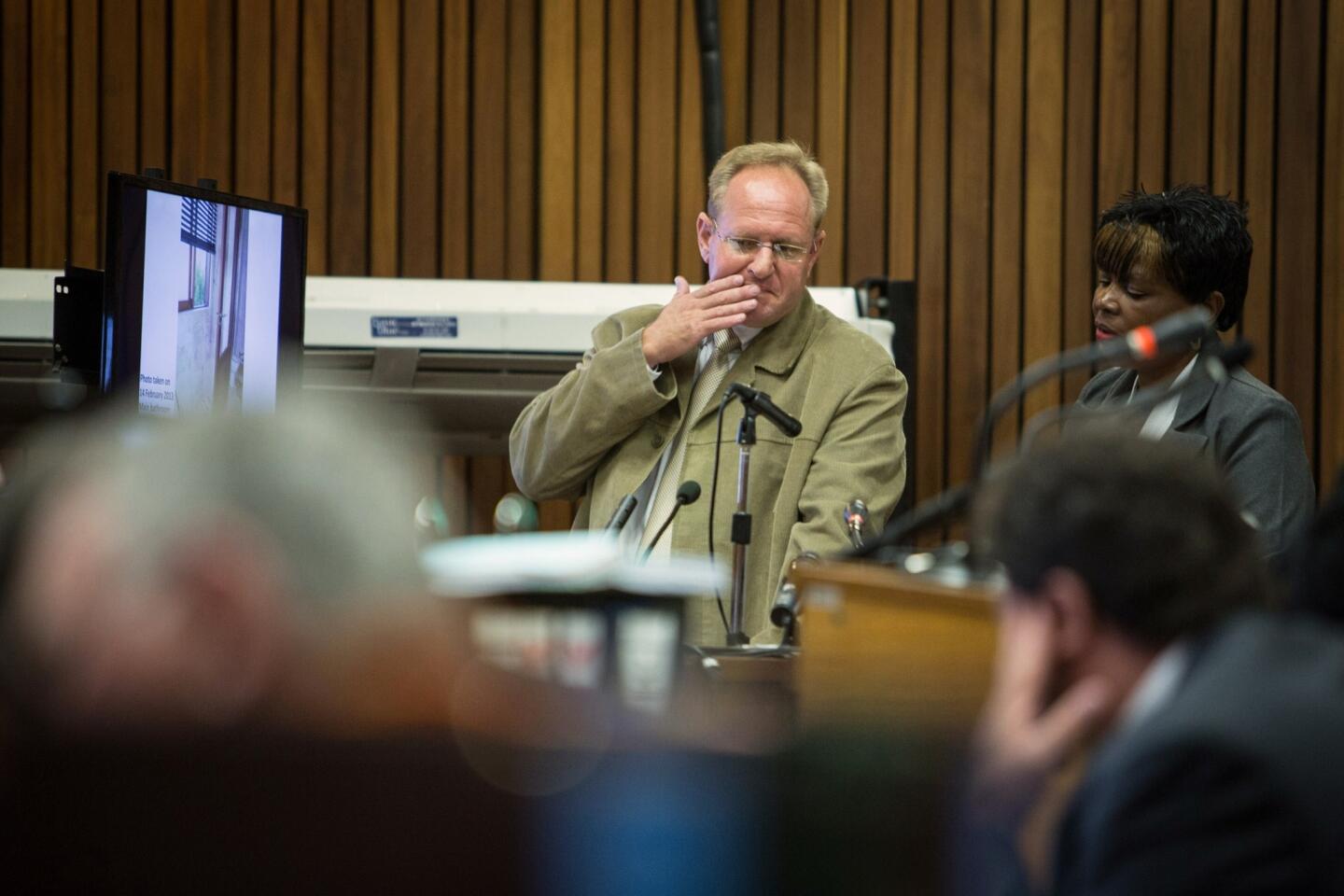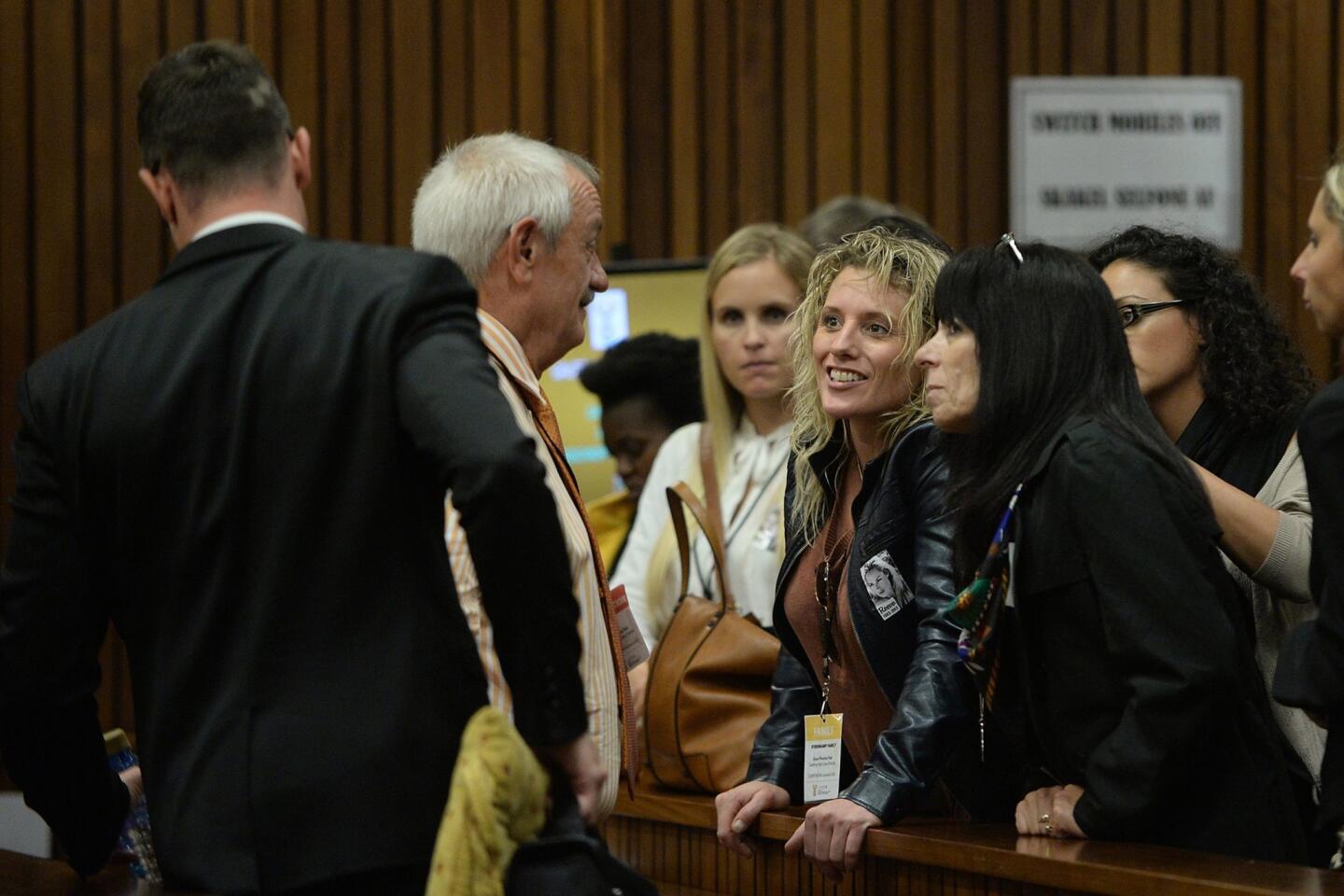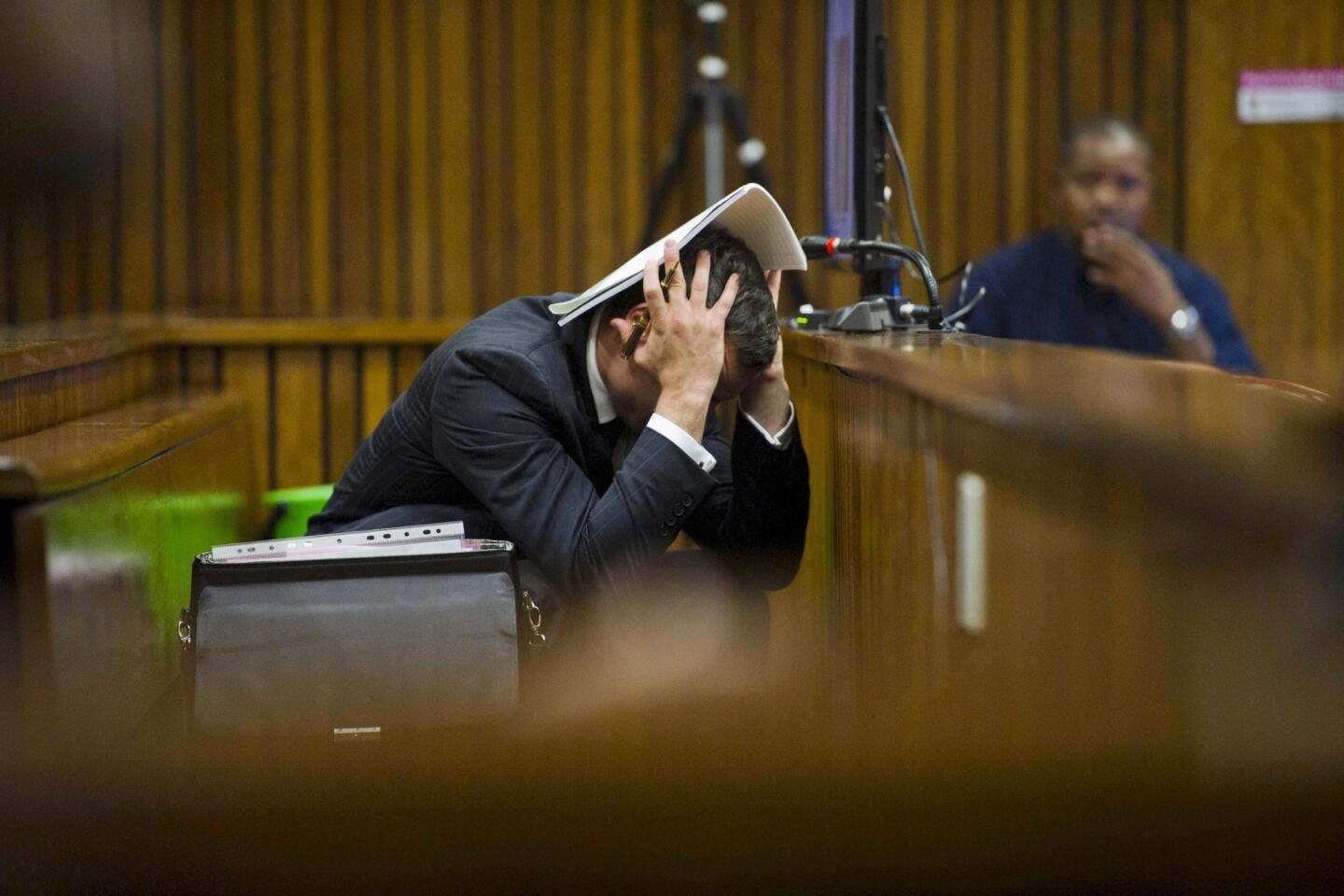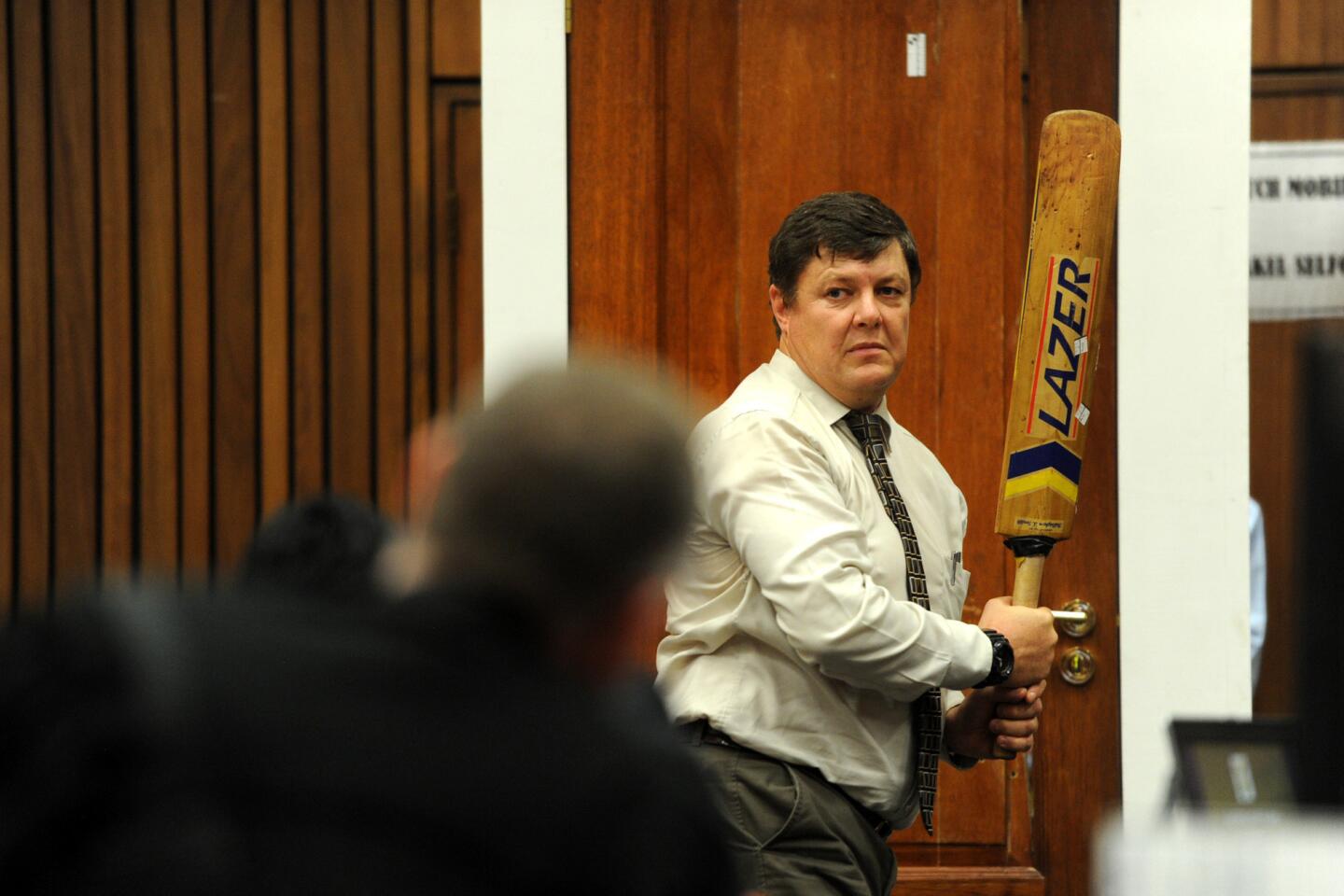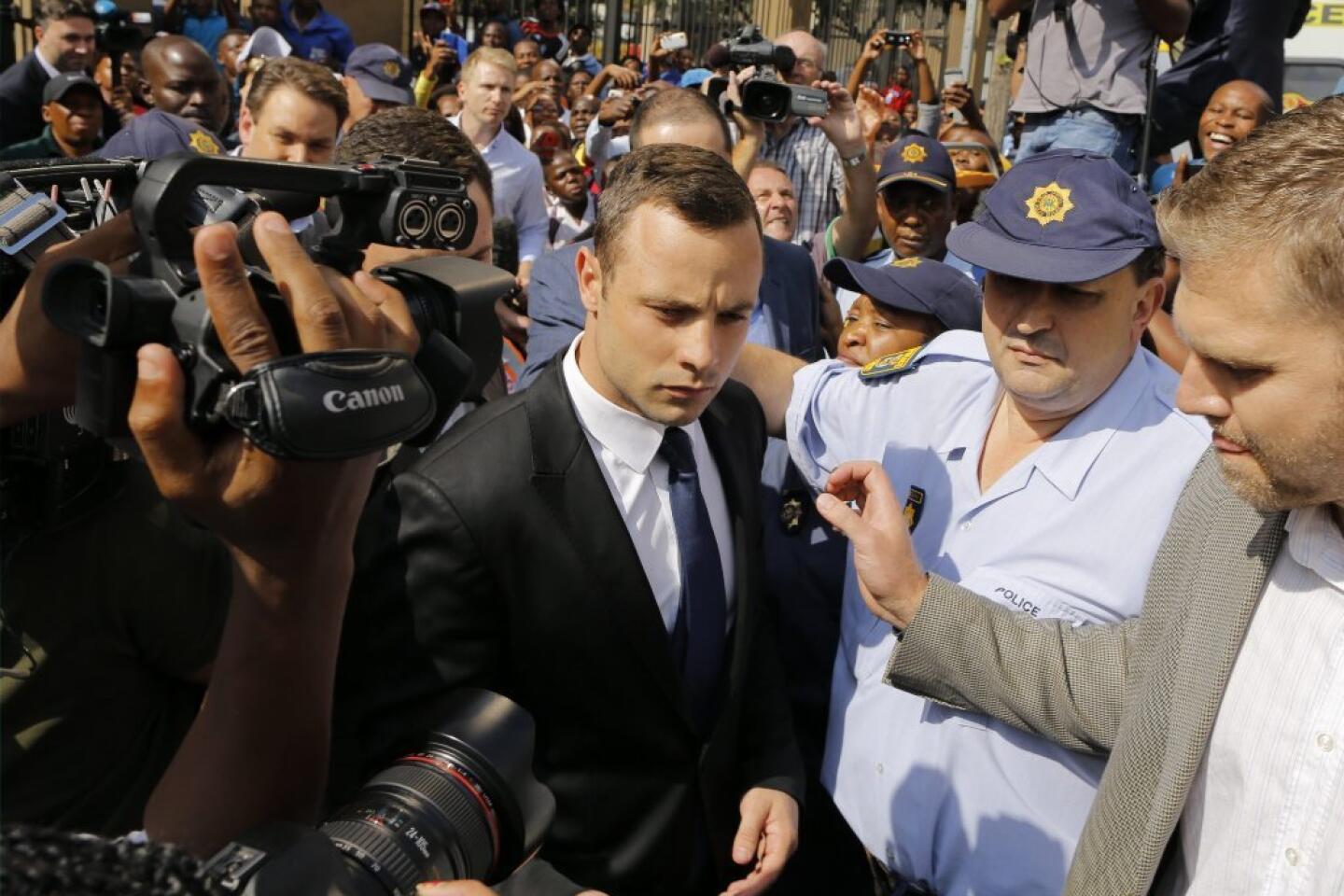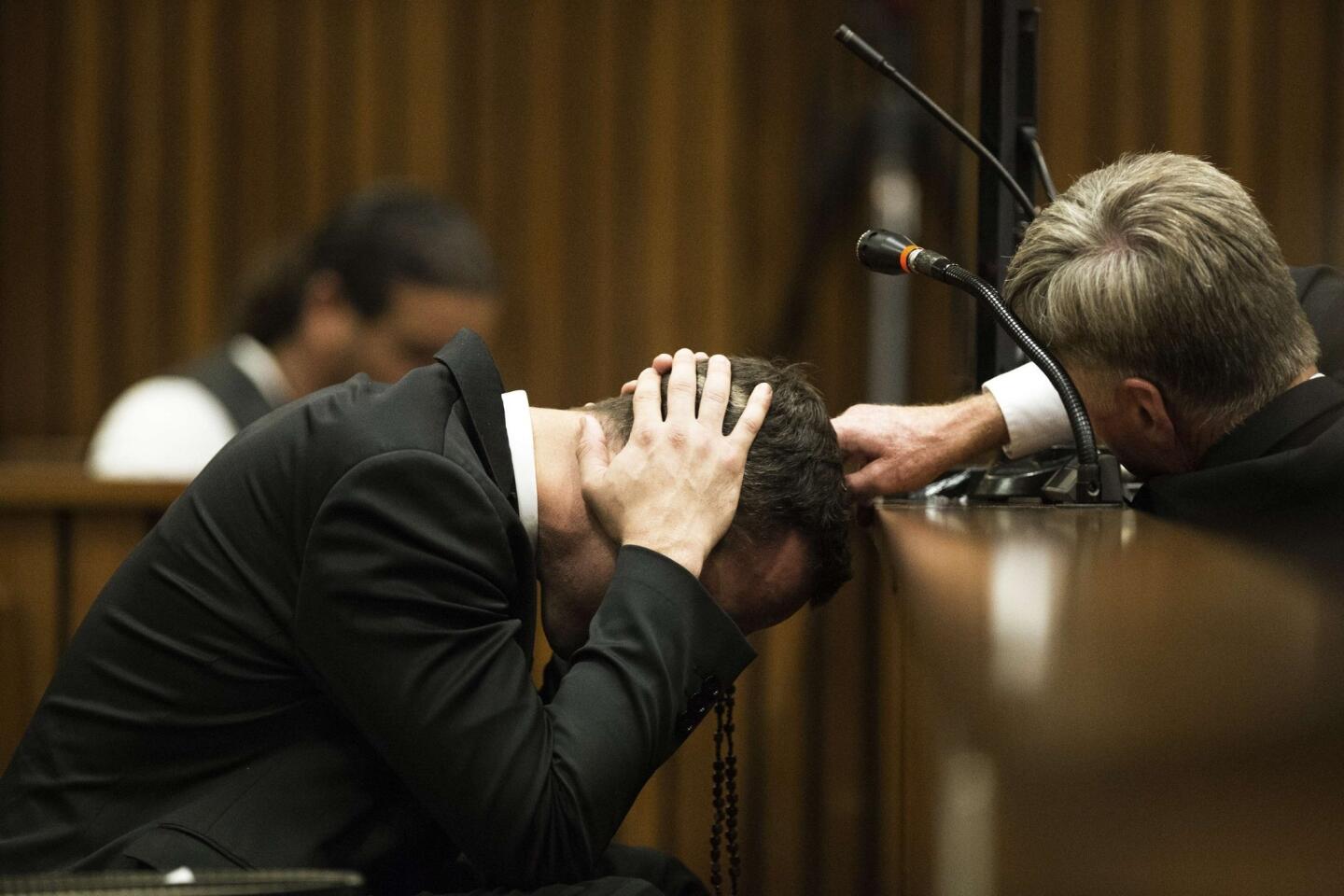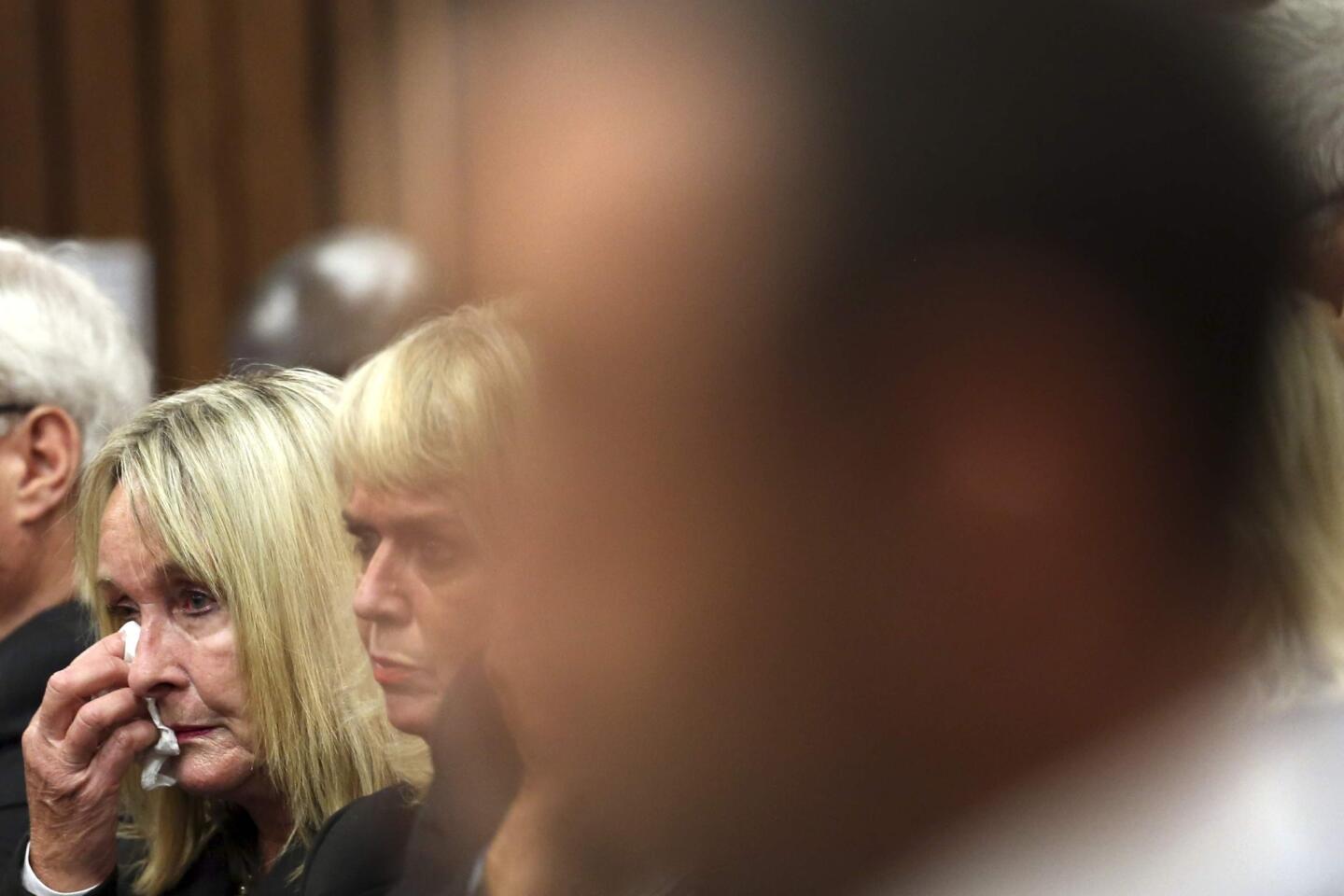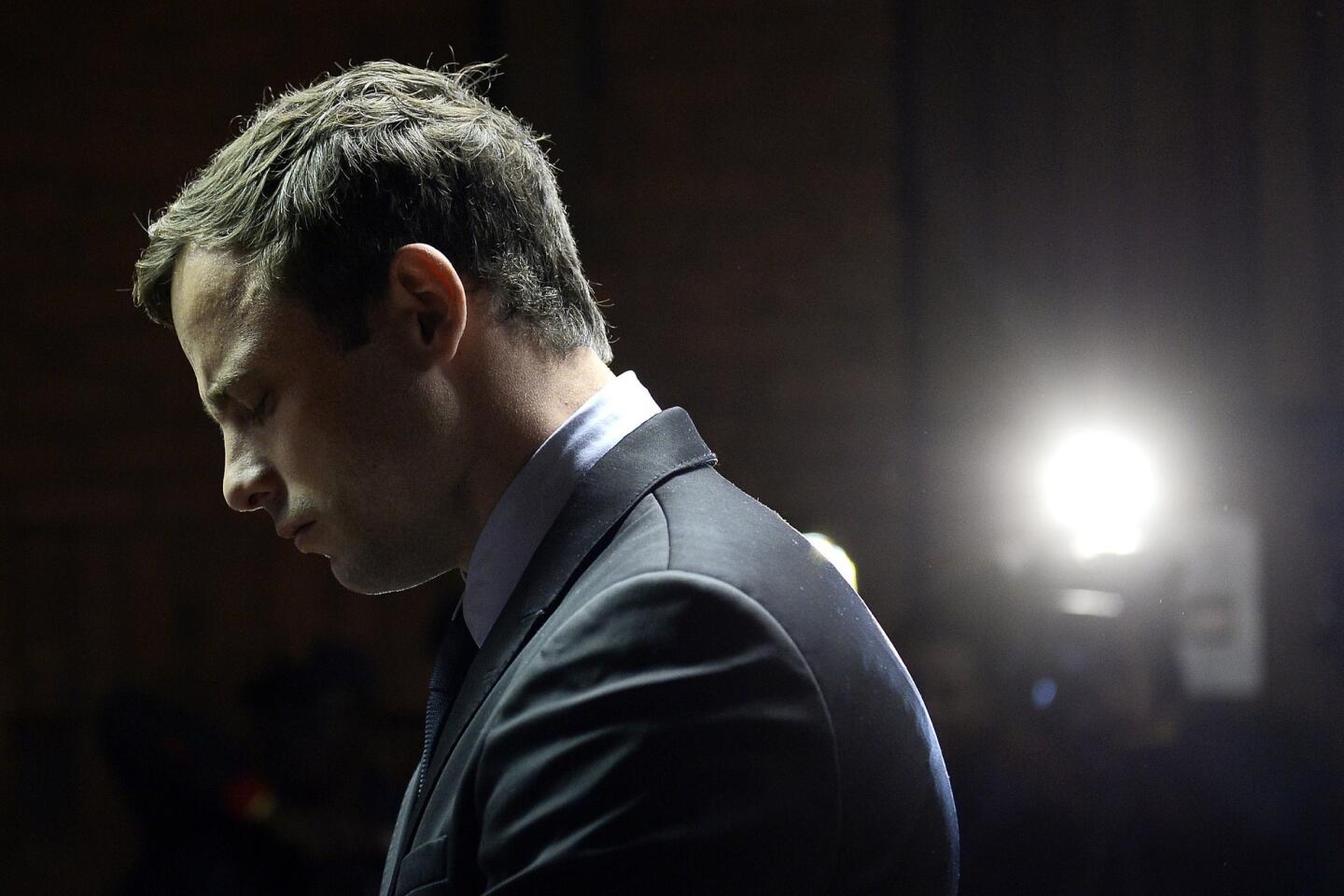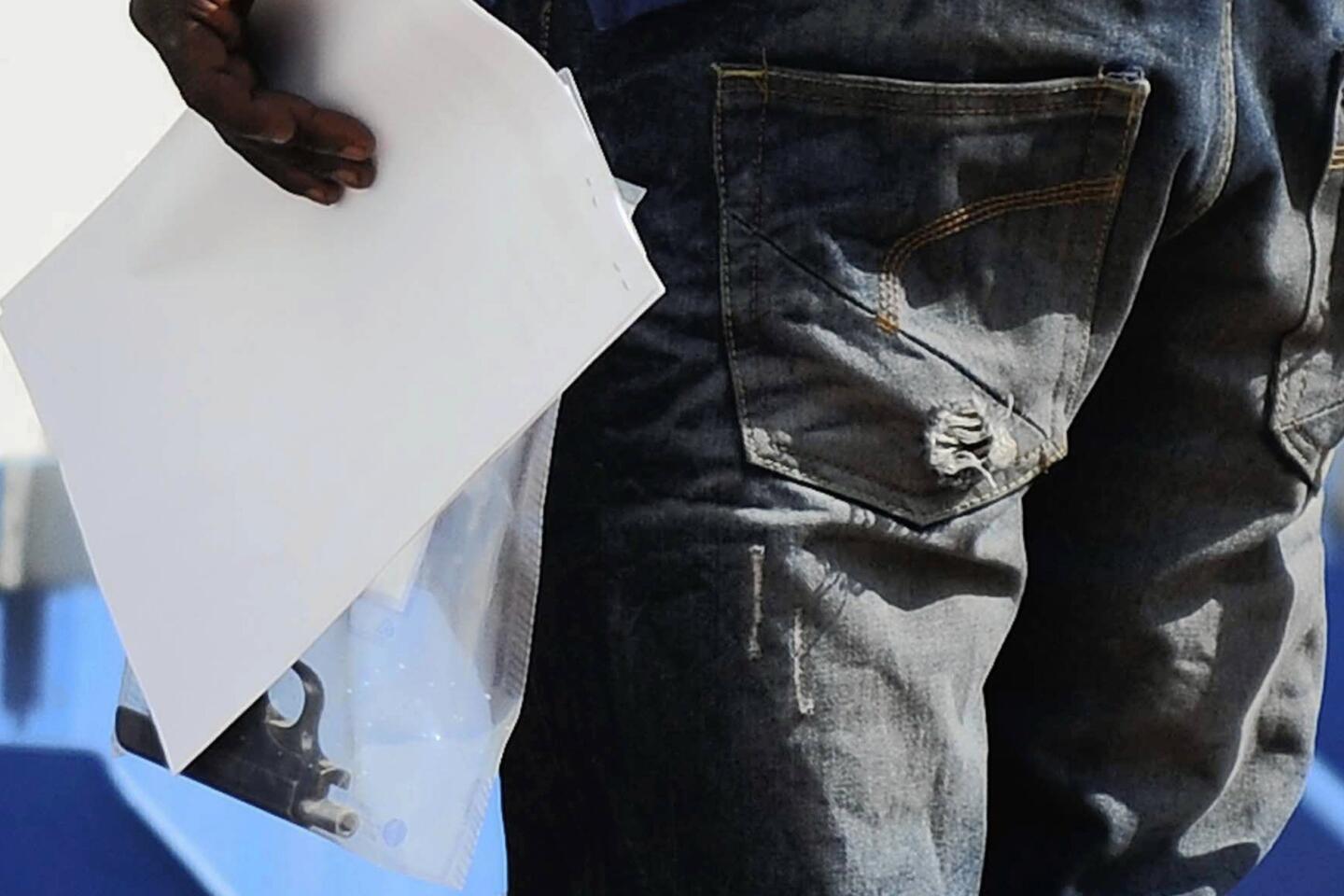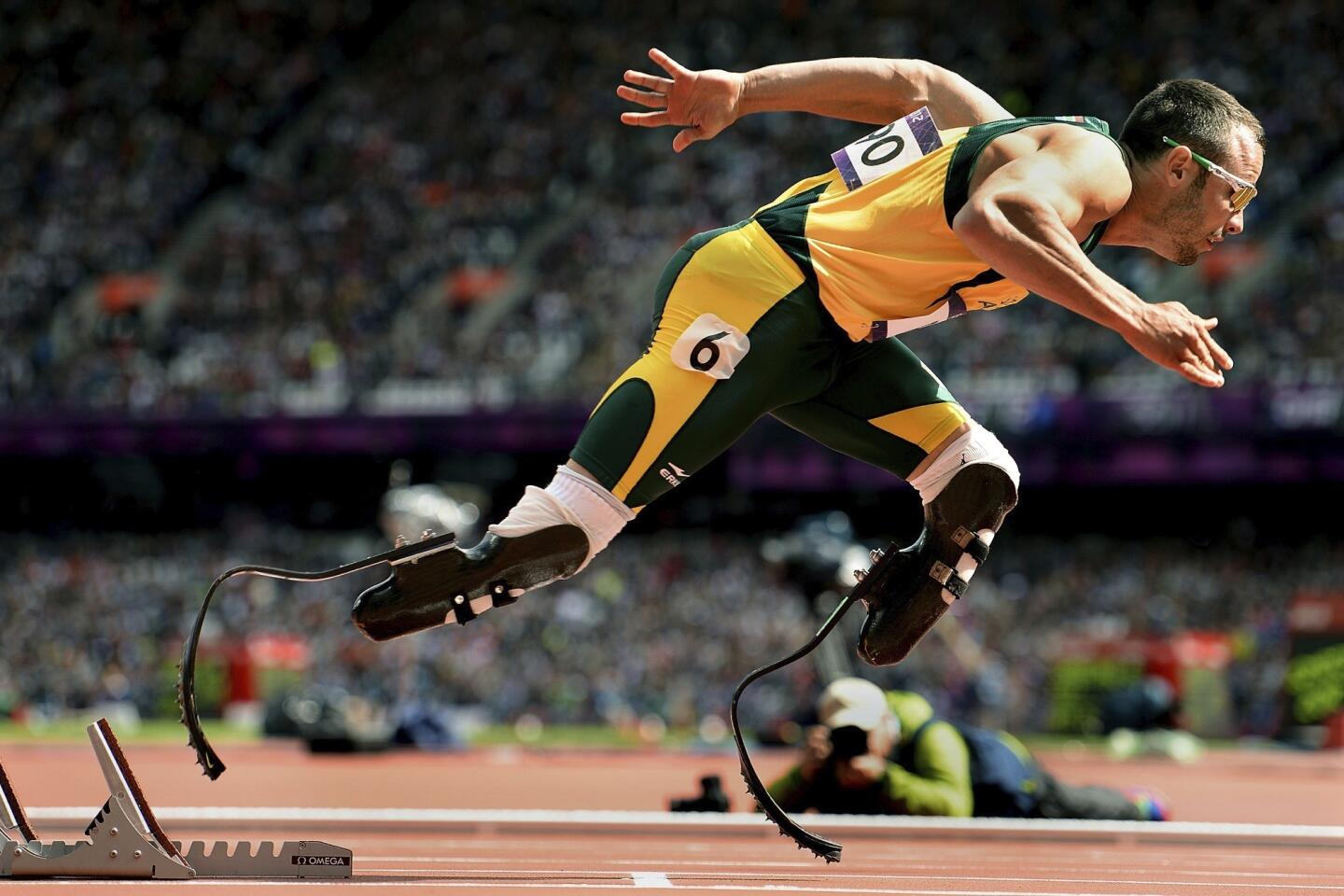Ballistics expert calls Oscar Pistorius claim in shooting ‘impossible’
- Share via
JOHANNESBURG, South Africa -- A police ballistics expert at the murder trial of South African Olympic athlete Oscar Pistorius on Wednesday rejected the athlete’s assertion that he fired two sets of rapid gunshots when he killed his girlfriend, testifying that her wounds made such a claim impossible.
Pistorius fired four gunshots through a closed bathroom door, but Reeva Steenkamp’s wounds were not consistent with the results of so-called “double taps,” said Capt. Chris Mangena, a prosecution witness.
Mangena testified that two sets of very rapid gunshots would have resulted in Steenkamp being struck in the waist, where the first gunshot hit her, by all the shots.
“If it’s two double taps, she’s in a standing position, all the wounds will be here, in this position,” he said, indicating the waist.
Instead, Steenkamp suffered wounds to her hip, arm and head, indicating there had been a pause between the first shot and the three that followed, Mangena said. Given the position of the wounds, he said, the double taps scenario was “impossible.”
Pistorius said in an affidavit at his bail hearing last year that he fired two double taps through the bathroom door. He has pleaded not guilty to murdering Steenkamp on Valentine’s Day 2013, contending that he mistook her for an intruder.
Mangena’s testimony in the Pretoria court offered graphic insight into the final minutes of Steenkamp’s life. Mangena told the court that Steenkamp, 29, was standing facing the door when Pistorius shot her the first time.
She immediately collapsed backward into a sitting position on a magazine rack behind her in the toilet off the bathroom, he said. Steenkamp raised her arms above her head in a defensive manner, according to Mangena.
Pistorius kept firing. One shot struck his girlfriend in her arm and exited. Another hit her left hand, which was trying to protect the right-hand side of her head, Mangena said. That bullet penetrated her skull. Another bullet hit a wall and ricocheted around the bathroom.
After being struck in the head, Steenkamp slumped to the right, Mangena told the court.
“I am of the opinion that after this wound was inflicted in the head she dropped immediately,” he said. “Her head ended up on the toilet seat.” The lower part of her body was still on the magazine rack, he said.
According to Mangena, had Steenkamp collapsed onto the floor instead of falling back into a sitting position on the magazine rack after the gunshot to the hip, the subsequent shots would have been too high to hit her -- at about 37 inches, 38 inches and 40 inches.
Medical experts earlier in the trial said the head shot would have killed Steenkamp.
Defense advocate Barry Roux said Wednesday he would call his own ballistics expert who would testify Steenkamp was likely standing and leaning over when she was hit. His expert would also offer a different analysis on the order in which the bullets were fired.
Col. Ian van der Nest, a blood stain pattern expert, said his analysis of the blood in the bathroom supported Mangena’s analysis of how Steenkamp died and her position when she toppled onto the toilet seat. Blood and hair on the toilet seat and open toilet lid had come from her head.
Van der Nest said it was clear that Steenkamp’s shorts were pulled up, not down, when she was killed, indicating she was not using the toilet.
He said blood stain evidence throughout the house suggested the victim was shot in the bathroom, dragged out and left on the floor for a brief time, before being carried downstairs -- a version that is common ground between prosecution and defense.
Describing the impact of a Black Talon-style expanding bullet, Mangena said, “It creates six talons and these talons are sharp. It cuts through the organs of a human being. If it hits a hard object like a bone it breaks into pieces.”
They do not expand when hitting a hard object such as a door, but are designed to open up when they hit moist objects, such as flesh, he explained.
Mangena said it was most likely that Pistorius was not wearing his prosthetic legs when he fired his gun and that he was standing at a distance of two or more feet from the door. The prosecution and defense agree that Pistorius was not wearing his legs at the time of the shooting.
Mangena drew no firm conclusion from the position of the spent bullet casings on the floor because they could have been kicked or moved. Under cross-examination, Mangena said their position was consistent with Pistorius’ version, that he stood at the bathroom entrance when he fired.
Pistorius has also been charged with two counts of recklessly discharging a gun, once in a restaurant in 2013 and once out of the sunroof of a car in 2012. He has pleaded not guilty to both.
Two earlier witnesses described Pistorius’ firing the gun out of a car sunroof after being angered by a policeman who had stopped the car and handled the gun. Mangena said it was dangerous to fire a gun into the air because the falling bullet could kill a person.
The weapon Pistorius fired in a restaurant in 2013 was a Glock pistol with a safety mechanism on the trigger. It wouldn’t have been possible to fire a shot without pulling the trigger, Mangena said.
Prosecutor Gerrie Nel also called a police cellphone and tablet analyst, Col. Mike Sales, who provided details of the Web history in two iPads found. In the evening before Steenkamp died, the user surfed used car sites, googled a Morgan Aeromax (a British sports car), and two porn sites. Sales could not say who that user was.
Nel said the prosecution was nearing the end of its case and he would called four or five witnesses next week. This means that Pistorius could testify next week, if he goes ahead with his stated intention to do so.
The case was adjourned until Monday.
Twitter: @latimesdixon
More to Read
Sign up for Essential California
The most important California stories and recommendations in your inbox every morning.
You may occasionally receive promotional content from the Los Angeles Times.




